Prime Wireless SoundBase Manual
Congratulations on bringing home the SVS Prime Wireless SoundBase, a stunning achievement in sound quality and audio connectivity. We want to make it as easy as possible for you to set up the Prime Wireless SoundBase, so this manual will walk you through downloading the DTS Play-Fi app and everything you need to know to get the most out of the Prime Wireless SoundBase experience. Our SVS Sound Experts are also available seven days a week to take the guess work out of anything. They are equipped to handle even the most complicated questions about connectivity, control, adjusting settings and optimizing sound quality.
One of the key features of the SVS Prime Wireless SoundBase is DTS Play-Fi. It enables WiFi connectivity with your home network and provides app control that unlocks direct streaming from Spotify, Pandora, SiriusXm, Amazon Music and many more popular music services. Play-Fi also allows multi-room audio playback, voice control via Amazon Alexa, Critical Listening mode and much more. You’ll want to download the app before doing anything else, so just visit the Apple® App Store, Google Play™ Store, Amazon Appstore or Microsoft Store and search “DTS Play-Fi” to get started.
If you have any questions about your new SVS Prime Wireless SoundBase, please contact the SVS Sound Experts.
To download and/or print this manual as a PDF, please click here: [Download PDF Manual]
Happy Listening!
What's in the Box

Prime Wireless SoundBase

AC Power Cord
Unpacking and Preparing Your Prime Wireless SoundBase
- Place Prime Wireless SoundBase in desired location, attach power cord and plug into wall outlet.
- Remove plastic film from front panel display by gently peeling off from the corner.
Front Panel Controls

Source & Preset Control
Rotate the left knob to change the input. Press the knob to select a preset (after they are programmed).
Front Panel Display
LED backlighting indicates the selected audio source (Wi-Fi, Bluetooth, Optical or Auxiliary) and preset (1-6).
Play, Pause & Volume
Rotate the right knob to adjust volume. Press the knob to pause/un-pause.
Headphone Output
Connect headphones for private listening.
Rear Panel Connections & Controls
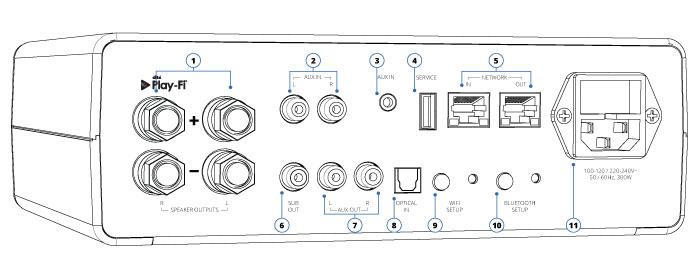
-
L/R Speaker Binding Posts
Connect speakers via speaker cables or wires. Accepts banana plugs, spades and bare wire terminations.
-
L/R AUX In
Connect any stereo source that has a left and right stereo analog output.
-
3.5mm AUX In
Connect to headphone outputs of smartphones, tablets or other audio devices.
-
Service USB
For firmware updates and charging USB devices like a smartphone, tablet or SoundPath Wireless Audio Adapter to make your subwoofer fully wireless.
-
In/Out Network
Connect standard Ethernet cable for hard-wired Internet connection.
-
Sub Out
Add a subwoofer using standard audio interconnect cable (not included) or the optional SVS SoundPath Wireless Audio Kit.
-
L/R AUX Out
Connect Prime Wireless SoundBase as a source for an existing device like an AV receiver or Preamp.
-
Optical In
Connect sources with optical digital outputs such as a TV or game console.
-
Wi-Fi Setup
Enables Wi-Fi set-up mode and shows status of wireless connection. Blinking yellow light indicates set-up mode, solid light means it’s set-up and ready to use.
-
Bluetooth Setup
Enables Bluetooth pairing mode and shows status of Bluetooth connection. Blinking blue light indicates pairing mode, solid light means it’s connected and ready to use.
- AC Power Cord Input
WiFi Network Requirements
To get the most out of your new SVS Prime Wireless SoundBase’s dual-band WiFi, you’ll need a router with 2.4GHz and/or 5GHz WiFi connectivity and a connected mobile device. Play-Fi is compatible with all routers that are Wi-Fi certified and meet Wi-Fi standards.
Note: Satellite internet services are prone to playback issues due to fluctuating download rates.
Note: Have your network password ready before connecting the SVS Prime Wireless SoundBase to your network.
Connection Options
Your Prime Wireless SoundBase streams music directly from your home WiFi network using the DTS Play-Fi app. You can also stream at the highest resolution possible from any Bluetooth enabled smartphone, tablet or computer.
Prime Wireless SoundBase can be connected directly to speakers via standard speaker wire or cables with the 5-way binding posts. It also has a line level output that transform AV receivers or two-channel audio systems in smart wireless audio zones. For direct connections to computers, TVs, Blu-ray players, gaming consoles and more; Prime Wireless SoundBase has a 3.5mm and L/R line level inputs and an optical input. A headphone output on the front panel enables private listening and a subwoofer output is also available for deeper and more powerful bass.
Instructions for setting up and using all of these connections can be found in this manual. If you have any questions during set-up, please contact our SVS Sound Experts for prompt and professional service: Email • (877) 626-5623 • Chat
Connecting Speakers via Binding Posts
- Connect Left and Right speaker cables or wire to +/- terminals on your loudspeakers.
- Connect speakers to matching Prime Wireless SoundBase Left and Right terminals via bare wire, banana plugs or spades, making sure +/- polarities match speaker connections.

Connecting as a Source via Line Level Output
- Connect RCA interconnect to appropriate L/R input on AV receiver or Preamp.
- Connect opposite end of cable to SVS Prime Wireless Soundbase L/R Aux Output.
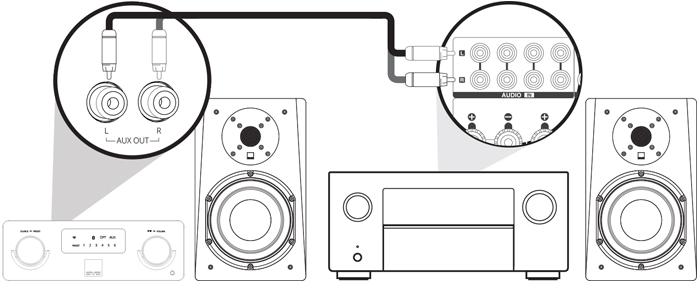
Setting Up WiFi And The DTS Play-Fi App
The DTS Play-Fi app offers a rich feature set that unlocks the full potential of your Prime Wireless SoundBase with smart, wireless control capabilities not available from any other wireless audio products. Downloading the app is an important first step towards getting the most out of your new system.
-
Download the Play-Fi App
Search “Play-Fi” in the Apple App Store, Google Play Store, Amazon Appstore or Microsoft Store and download the free DTS Play-Fi app to start unlocking the full potential of your new Prime Wireless SoundBase.
-
WiFi Set-up Mode
Once powered on for the first time, the Prime Wireless SoundBase will automatically go into WiFi setup mode, indicated by a rapidly blinking yellow light on the rear panel. When the blinking light slows down to a slow pulse, it is ready to connect. WiFi connection will be confirmed when yellow light remains on permanently.
-
Connect to WiFi Network
iOS users must go to the “Settings” -> “WiFi” on their mobile device and select the “PlayFiDevice…” like you would a normal Wi-Fi network then open the Play-FI app to continue.
Android users just need to open and run the Play-Fi app.
-
Configure Play-Fi App
Open the Play-Fi app and follow the prompts to finish setting up your Prime Wireless SoundBase on your home WiFi network (image 9a and 9b).
From here, the app will find your Prime Wireless SoundBase and connect it to the WiFi network for you. You will type in your network password once (image 9c), and the app will do the rest. It’s important not to close or exit out of the app until the process is full complete or it may disrupt the configuration.
During installation, the Play-Fi app will look for and install any updates. These updates add 3-5 minutes to the installation time.
Once network set up and updates are completed, you can select a name for your new Prime Wireless SoundBase (image 9d), control volume (image 9e) and start enjoying music from your favorite streaming services (image 9f).
Image 9a.

Image 9b.
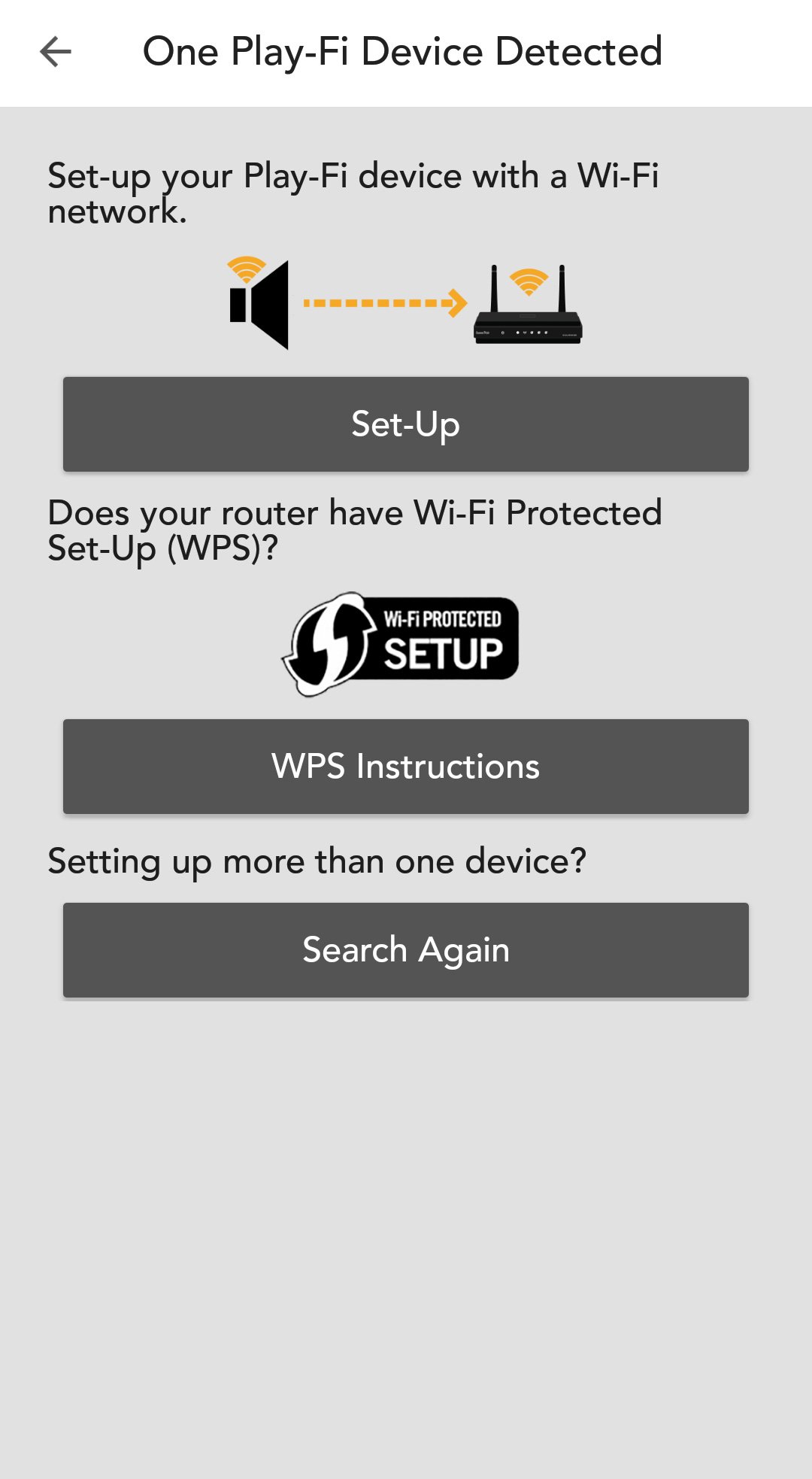
Image 9c.

Image 9d.

Image 9e.

Image 9f.

Having Trouble Connecting?
The Prime Wireless SoundBase may require an update before letting you stream music. The Play-Fi app will show a notification and complete the update automatically. This is completely normal and can take 3-5 minutes.
If it’s not being discovered by the WiFi network, try moving it closer to your router or to a stronger signal area to establish a connection. Also, make sure the Prime Wireless SoundBase and app are both configured to the same WiFi network in your home.
Not going into setup mode?
Standard Set-Up Mode: To put the device into Standard Set-Up Mode, hold the WiFi button down for 8 seconds. You will hear a tone at 4 seconds, but do not release the button until after you hear the same tone again after the full 8 seconds. The product will now be in Standard Set-Up Mode, and the WiFi light will slowly pulse on and off.
WPS Mode: To put the device into WPS Mode, hold the WiFi button down for 4 seconds. At 4 seconds you will hear a tone and the WiFi light will begin to blink a pattern of two times on and then a pause and then repeat. It is now ready for WPS pairing.
If you have any questions during WiFi set-up, please contact our SVS Sound Experts: Email • (877) 626-5623 • Chat
Audio Streaming Guide
Connect. Select. Play.
Once your Prime Wireless SoundBase is set up, you can access music from your smartphone, tablet and computer and stream your favorite music services directly via your home’s WiFi network using the DTS Play-Fi app. You can also enjoy ultra high-resolution Critical Listening Mode, create a multi-room audio system and enjoy all the benefits of the DTS Play-Fi app.
Setting Up Custom Presets
A unique feature of the Prime Wireless SoundBase, the six custom presets give you instant access via WiFi to your favorite playlists, Internet Radio stations and streaming music services that exist within the DTS Play-Fi app, without needing a phone or tablet. Simply walk up to your Prime Wireless SoundBase, push the knob and your favorite music will start playing.
- From the Play-Fi app, start the streaming service you want to program as a preset.
- Firmly press the left control knob to select which preset you want to program (1-6). Each time you press the knob, it will move to the next preset.
- When desired preset number is selected, press and hold the preset knob for about three seconds. The preset number will blink several times then remain highlighted to indicate the preset has been programmed, and music will resume playing.
- Follow instructions above for the remaining five presets.
NOTE: It takes a few seconds for the preset to connect to music services from your WiFi network. The preset number will flash while it establishes a connection and remain highlighted once connected. This delay is completely normal.
- You can now access your favorite content by firmly pressing the left knob to toggle through your presets at any time.
- To re-program a preset, simply repeat steps 1 – 3.
NOTE: When setting up Pandora or Spotify as Presets, the app may ask you to sign into your account first.
Enabling Critical Listening Mode
Critical Listening mode will enable native rendering of high-resolution files up to 24-bit/192KHz, with no down-sampling or network synchronization adjustment.
- When you start the Play-Fi app, before selecting your Prime Wireless SoundBase, tap the Hi-Res button in the top bar of the zone module (image 12a).
- The Hi-Res logo will turn gold, the app will display CRITICAL LISTENING MODE, and the list will only display the products that are compatible with this mode (image 12b).
- Select the Prime Wireless SoundBase you want to stream to (only one can be selected), and then play from your desired source for the truest audio reproduction possible over WiFi.
Image 12a.

Image 12b.

Using Spotify Connect
Spotify works differently from the other streaming services. Instead of Spotify living in the Play-Fi app, the Play-Fi product itself communicates directly with Spotify.
To use Spotify Connect you must have a Spotify Premium account.
- Open up your Spotify app, sign in and start playing something.
- On the Now Playing screen, press the “Devices Available” button, which we’ve circled below (image 13a).
- You'll then be able to see all the Spotify enabled devices on the network, including your Prime Wireless SoundBase, that have been configured as Spotify Groups, or just individual products. The selected products are now tied to your Spotify Premium account, and as long as the product can communicate with the Internet, you can play to it from your Spotify app (Image 13b-13c).
NOTE: You can stream Spotify to your Prime Wireless SoundBase from your smartphone using the mobile app or a computer via the desktop app. Both apps update in real time so you can start streaming from the desktop app, leave the room, open the app on your phone, and control all functions without interruption.
Image 13a.

Image 13b.

Image 13c.

Streaming Spotify In Multiple Rooms
Spotify Groups are different from normal Play-Fi groups in that they specifically group speakers together for viewing within the Spotify app. This is so that normal grouping and zoning functions remain modular within the Play-Fi streaming system.
- First create a Spotify Group within the Play-Fi app. From the Play-Fi Control screen of the Play-Fi app, tap the Settings button to open the pop-up menu, and select Spotify Groups, which we’ve circled below. This option allows you to edit or create Spotify Groups (image 14a).
- After you've elected to create a new group and given it a name (we labeled it "Downstairs" in the example) you can then pick from any of your Prime Wireless products to be added to this group. Any speakers that can't be joined in a Spotify Group will be greyed out. Once you’re done, head to the Spotify app to start streaming (images 14b, 14c and 14d).
- If you want to control the volume of individual products within the Spotify Group after you’ve started your stream, head back to the Play-Fi app, and your Spotify Group will automatically populate a module on the Play-Fi Control screen (image 14e).
- For more information on using Spotify Connect, please visit the DTS Play-Fi Knowledgebase.
If you have any questions during Spotify set-up, please contact our SVS Sound Experts: Email • (877) 626-5623 • Chat
Image 14a.

Image 14b.

Image 14c.

Image 14d.

Image 14e.

Creating Speaker Groups
You can add more Prime Wireless SoundBases or other dts Play-Fi enabled speakers or amplifiers at any time when using the Play-Fi app, or from the Play-Fi applet in Windows in a few easy steps. Once added, speakers can be combined into a “Group” that allows the same content to be played across all speakers in the group.
- Tap the Play-Fi icon. In the app, it’s the orange triangle icon on the bottom right side of the screen, and in Windows, it appears as a system icon in the lower bar. This will open the Play-Fi Control screen.
- From the control screen, you can see the speakers tied to each source and adjust their volume individually or all together. Pressing the Add/Remove button (image 15a) will expand the speaker list to all of those on your network and allow you to select or deselect speakers for a Group (image 15b).
- Select the speakers you want to include and tap the “Save as Group?” option at the bottom. Then tap "Create Speaker Group" (image 15c), name the group (image 15d) and you're all set.
- To create new groups or edit groups outside of playback, just hit the “Settings” button on the Play-Fi Control screen, select the “Speaker Groups” (image 15e) and repeat the steps above.
Image 15a.

Image 15b.
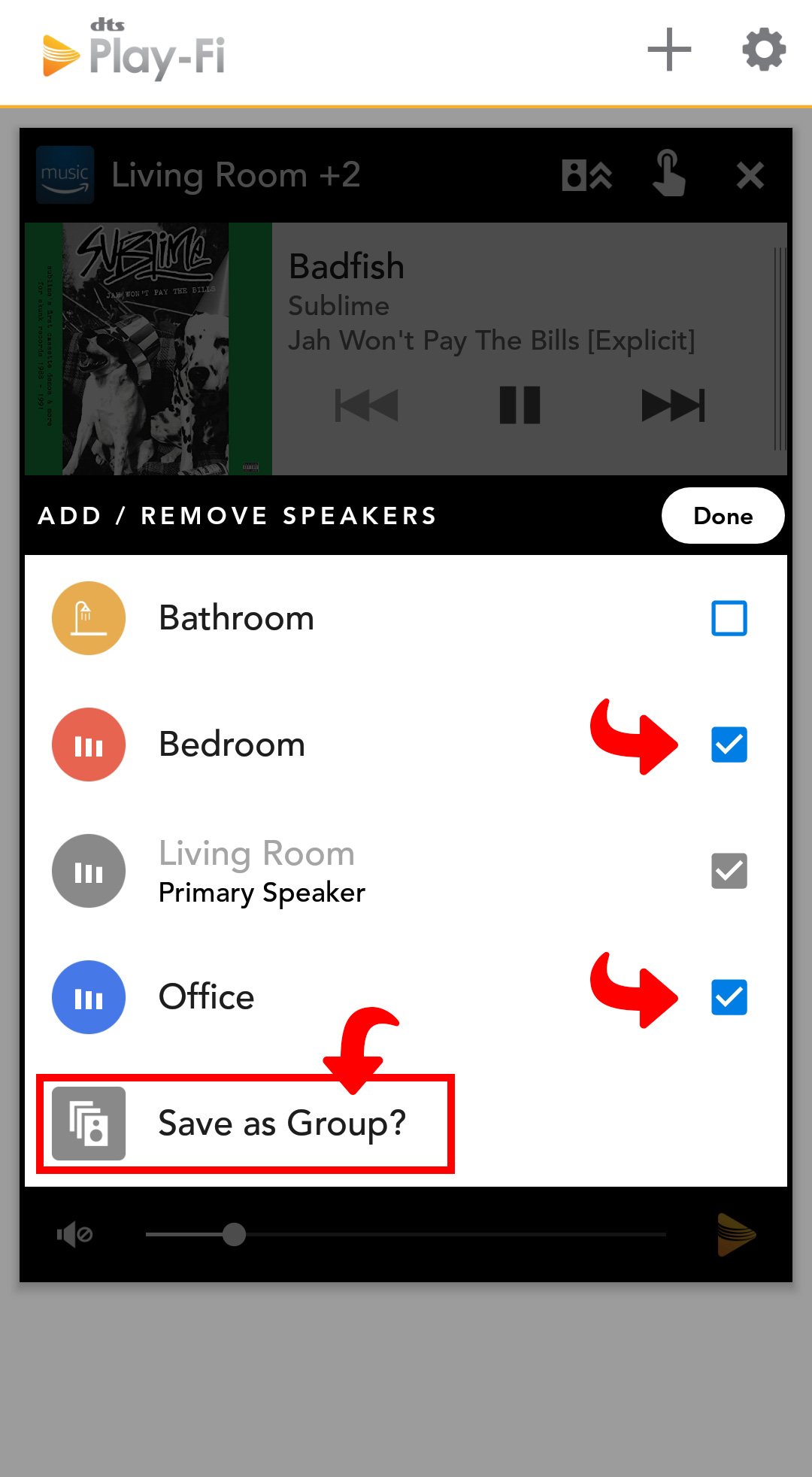
Image 15c.

Image 15d.

Image 15e.

Multi-Zone Streaming
When additional Prime Wireless products are added, Play-Fi supports streaming different audio to different rooms or zones, directly from the Play-Fi app. So, for example, you can send Pandora downstairs for a dinner party, and keep Radio Disney playing upstairs for the kids.
- To set up a new zone, open up the Play-Fi Control screen by pressing the Play-Fi button in the app.
- You will see the currently playing products and what they are playing in a Zone module.
- To add another Zone, simply press the Plus (+) icon in the top right of the screen (image 16a).
- A new Zone module will be created allowing you to pick your speakers, and then you can select your music source (image 16b).
- Once configured, you can press the Play-Fi button to return to the Play-Fi Control screen, where you can easily manage each Zone.
NOTE: You can have up to four zones at once, and each zone can include up to 16 speakers.
NOTE: Each zone does have to play from a different music source or server.
Image 16a.

Image 16b.

Streaming a “Line-In” Audio Input
Prime Wireless products have the capability to capture audio from one of their on-board audio inputs and then redistribute it through a Play-Fi group. This is called Line-In Streaming, and speakers paired together streaming from Line-In are called a Line-In Zone.
- To initiate a Line-In Zone, simply tap on the Add Zone button—which is the little + icon at the top of the main Play-Fi Control screen—then select the Line-In option (image 17a).
- The Line-In screen will display and list the products you can pick to lead the zone (image 17b).
- After selecting the product, if it has more than one audio input, you'll be able to select which one you'd like as the source.
- You can also select between the type of content, which includes a Music mode and a TV audio mode to optimize the listening experience for each different source.
- Lastly, you'll be able to select the additional Play-Fi products to join to the Line-In Zone.
NOTE: The app automatically remembers your last configuration, so that you can start streaming quickly the next time.
Once you're ready to go, just tap the Start button, and the app will send all the information over to the host product so that it can configure the zone (images 17c, 17d). Now that everything is up and running, you can close the app or leave the network, and the Line-In Zone will continue to run so long as there is content being played on its input.
Image 17a.

Image 17b.

Image 17c.

Image 17d.

Setting Up Bluetooth
Establishing a Bluetooth connection allows you to wirelessly stream to your Prime Wireless SoundBase from any smartphone, tablet or Bluetooth enabled device at the highest resolution possible.
- Press the Bluetooth Setup button on rear panel of the Prime Wireless SoundBase once to activate Bluetooth pairing. This is indicated when the blue LED on the rear panel goes from slow to a rapid blinking.
- Select Bluetooth as your source by rotating the left knob until the Bluetooth logo on the front panel display is highlighted.
- View Bluetooth settings on your smartphone or mobile device and connect to “SVS SOUNDBASE...”
- Confirm pairing when the light stops blinking and remains on.
- You can now stream music services and audio content directly from your paired device any time you select Bluetooth as your source.
Connecting Devices via Aux and Optical Inputs
Your Prime Wireless SoundBase is equipped with multiple input connections that allow it to provide audio playback for a wide array of devices, including: computers, TVs, AV receivers, Blu-ray players, gaming consoles, handheld devices, turntables with phono preamps and more. Connecting these devices to your speakers is as simple as plug-and-play.
- Ensure the device you want to connect has the appropriate AUX or optical output.
- Check to see that you have the proper optical, stereo RCA or 3.5mm RCA cable (not included) for connecting your device and the Prime Wireless SoundBase.
- Connect your device to the Optical input, L/R AUX stereo inputs or the 3.5mm AUX input on your Prime Wireless SoundBase.
- Select the input by rotating the left control knob. The source will be displayed on the front panel with backlighting.
- Select “OPT” for audio playback of devices connected to the Optical input.
- Selecting “AUX” will allow you to access both the stereo L/R inputs or the 3.5mm line level input.
NOTE: If devices are connected to both the 3.5mm AUX inputs and the L/R RCA AUX inputs, the 3.5MM input will override the L/R AUX inputs.
- Operate device as normal.
- Volume can be controlled from the right-hand control knob or from the Play-Fi app.
- Simply open the app and the default screen will show a scrolling volume control bar for whatever input you have selected.
If you have any questions about connecting via line level inputs, please contact our SVS Sound Experts: Email • (877) 626-5623 • Chat
Connecting A Subwoofer
For deeper and more powerful bass, a subwoofer output allows you to directly connect a subwoofer from SVS or any other brand.
- Locate the “LFE” input on your subwoofer and connect a standard RCA Audio interconnect cable.
- Connect opposite end of cable to the “SUB Out” output on your Prime Wireless SoundBase.
- Set the Low Pass Filter on the subwoofer to whatever crossover frequency the speaker manufacturer recommends. You can also use the SVS Subwoofer Matching Tool for recommended settings.
- Adjust the gain (volume) on the subwoofer to blend based on your personal preferences.
Setting up/Using Amazon Alexa Voice Control
Prime Wireless SoundBase does not have a built-in microphone. You'll need an Amazon Alexa enabled product like a Dot, Echo or other to communicate voice commands to your system and to "Discover Devices" so that your Prime Wireless SoundBase can be identified.
Voice control of music from any Amazon Alexa Device on your WiFi network is as simple as, “Alexa, play reggae in the living room,” and you can adjust volume, skip track forward, mute, pause and stop the music. Set-up requires just a few simple steps.
Directions for Setting Up Amazon Alexa
- Once you’ve joined your Prime Wireless product to the network using the Play-Fi app, the app should automatically prompt you to link it to your Amazon account. Make sure your Amazon Alexa device is powered on and connected to the same WiFi network.
NOTE: If you don’t see the prompt, or are linking your Amazon account after the fact, you can get to the below screen by going into Settings in the Play-Fi app and selecting the Amazon Alexa option, as directed below.
NOTE: Depending on your location, you may be prompted to select your default language for Alexa. Once ready to proceed, Alexa will prompt you for your Amazon account, but if you’ve already used an Amazon sign-on or authentication on your device before, it should automatically apply the credentials for you.
- Open the Play-Fi app, go to “Settings”. Find “Amazon Alexa” (image 22a) and select the Prime Wireless device to use with Alexa (image 22a). Follow prompts to sign in and verify your Amazon account (images 22c - 22e).
- After your device is registered, you will be prompted to launch the Amazon Alexa App (or download it if it’s not already installed) to finish the Alexa setup (image 22f).
- Within the Amazon Alexa app, choose the specific Amazon Alexa device you will be connecting, and select language for your Echo if prompted.
- Find the Play-Fi skill by going to the menu, clicking on “Skills & Games” and searching for “Play-Fi” (images 22g, 22h and 22i).
- Click “Enable” then “Allow” to finish linking the Play-Fi skill (images 22j-22l).
- Once the skill is successfully linked, the Alexa will begin searching for compatible devices. Once complete, select your Prime Wireless device to use with Alexa. Make sure the Prime Wireless device is set to “Enabled” within the device settings (images 22m-22o).
Image 22a.

Image 22b.

Image 22c.

Image 22d.
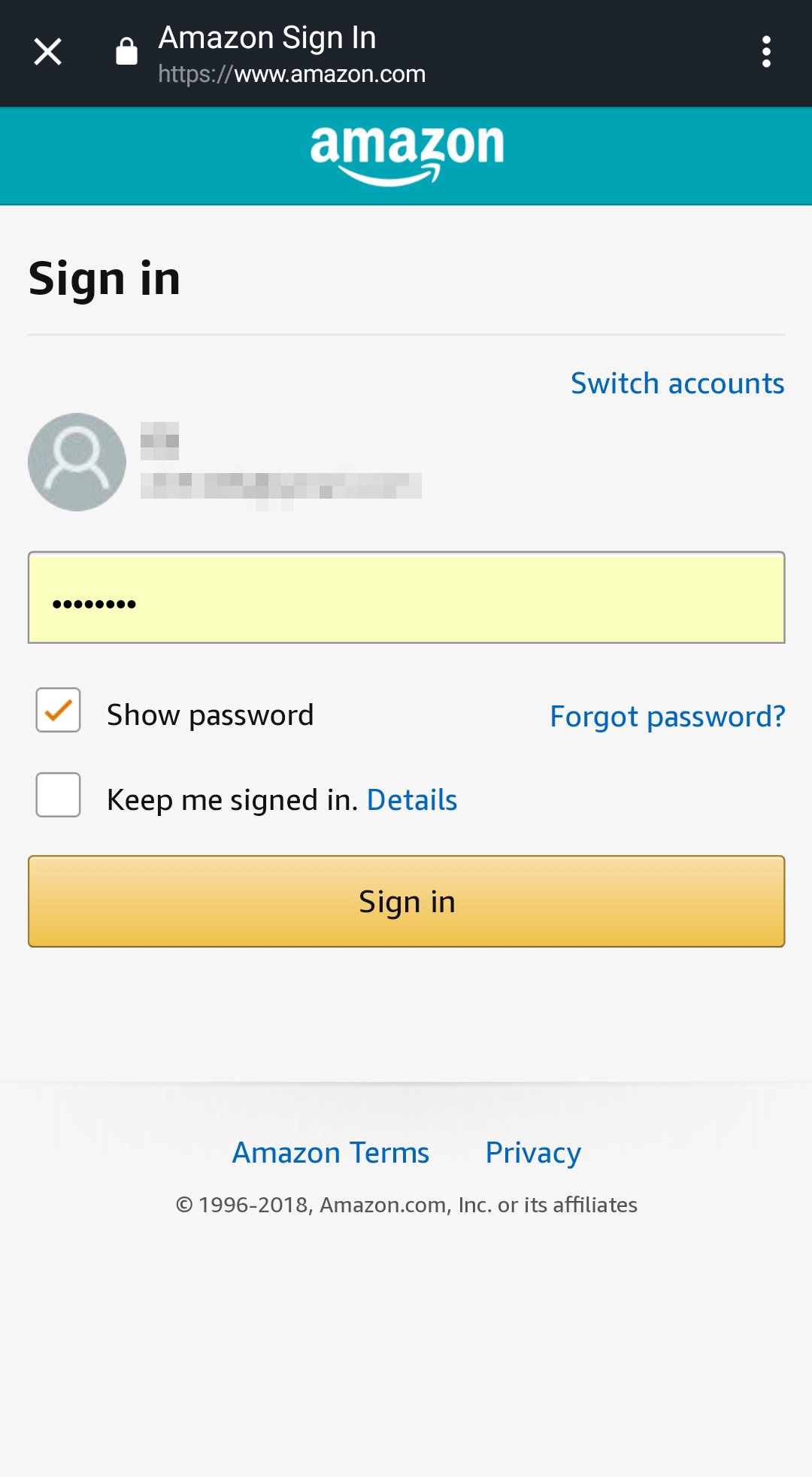
Image 22e.

Image 22f.

Image 22g.

Image 22h.
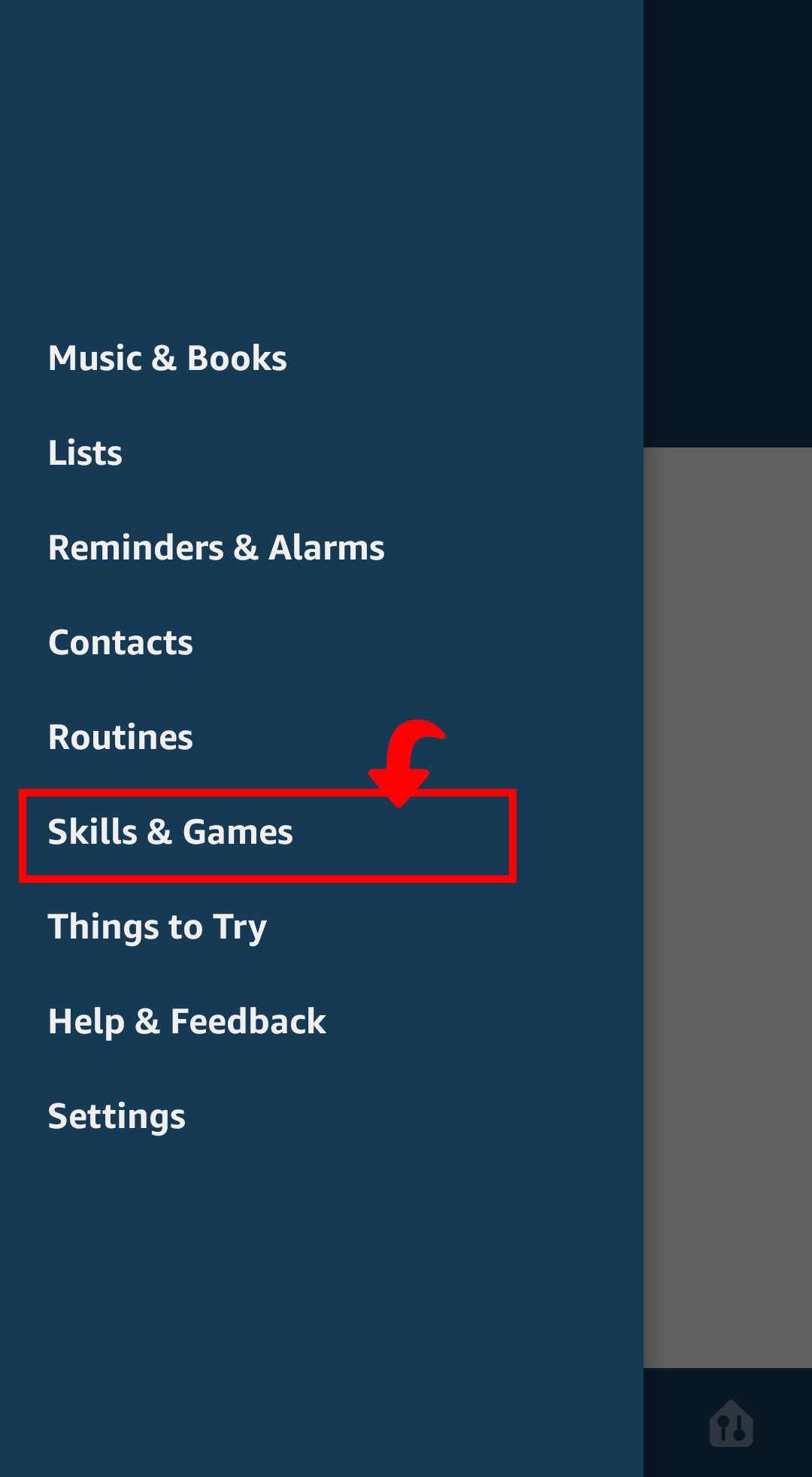
Image 22i.

Image 22j.

Image 22k.

Image 22l.

Image 22m.

Image 22n.

Image 22o.

Controlling With Amazon Alexa Voice Commands
Below is a simple list of commands you can use with your Prime Wireless SoundBase once connected. Keep in mind, these commands are simplified, but Alexa will understand and interpret some natural language, so saying “Stream” instead of “Play”, or “on” instead of “in” is also acceptable.
Initiating Streams (example: Alexa play Reggae in the Living Room)
Alexa Play [Artist] in [Zone]
Alexa Play [Album] in [Zone]
Alexa Play [Song] in [Zone]
Alexa Play [Station] in [Zone]
Alexa Play [Podcast] in [Zone]
Alexa Play [Song] from [Album] by [Artist] on [Music Service] in [Zone] or less specific variations of this and everything in-between
Controlling Streams (Alexa or DTS Play-Fi)
Alexa Next or Next Track
Alexa Previous or Previous Track
Alexa Pause or Stop or other variations
Alexa Play or Resume
Alexa Set Volume to [1 through 10] in [Zone]
Alexa Louder in [Zone]
Alexa Quieter in [Zone]
Alexa Mute in [Zone]
Alexa Unmute in [Zone]
Special Streaming Service Functions (depending on service and stream type)
Alexa Loop
Alexa Shuffle
Alexa Like this
Alexa Unlike this
Alexa Skip Forward 30 Seconds
Alexa Skip Backward 30 Seconds
If you have any questions about installing or using Amazon Alexa with your Prime Wireless SoundBase, please contact our SVS Sound Experts: Email • (877) 626-5623 • Chat
Rebooting Your System
Simply unplug the Prime Wireless SoundBase for 10 seconds, then plug it back in.
NOTE: The system will reboot and all previous settings will still be there.
Initiating A Factory Reset
There are a few reasons why you might need to restore your Prime Wireless SoundBase to its original factory settings, including: pairing with a new router, changing the assigned WiFi network, clearing out all the presets, or clearing out all connected Bluetooth devices.
Note: All saved settings will be lost.
To initiate a factory reset:
- Press and Hold both the WiFi and Bluetooth pairing buttons on the rear panel, as well as the Play/Pause knob on the front panel until you hear a series of two audible beeps.
- The reset will begin after the second audible beep.
Note: All saved settings will be lost.
Caring For Your Prime Wireless SoundBase
Your device may be gently cleaned as follows:
- Use a dry microfiber duster to remove any loose surface dust.
- Use a water-damp, lint-free microfiber cloth to remove fingerprints, smudges and other contaminants. Be extremely careful not to allow any moisture into the cooling vents on the top of the SoundBase.
- Follow any damp cleaning immediately with a dry microfiber cloth.
Router Optimization
Most modern routers are already set up to work really well with streaming products like Play-Fi, but even with current routers, there are some things you can check to make sure you get the best possible Play-Fi experience before setting up your Prime Wireless SoundBase.
- Select the best WiFi channel for your network.
- Enable Quality of Service (QoS) features like Wireless Multimedia Extensions (WMM)
- If using advanced DHCP assignments or port-forwarding, allow exceptions for Play-Fi
- Double-check to be sure your router is assigning network access and that UPnP and DHCP are enabled.
For more information on Play-Fi and wireless troubleshooting visit play-fi.com.
2-year Unconditional Warranty
SVS offers the industry's most comprehensive warranty on all our products. SVS warrants the Prime Wireless SoundBase to be free from defects in the workmanship for 2 years from date of purchase. This, and all of the SVS customer Bill of Rights can be viewed online at www.svsound.com/pages/bill-of-rights.
Additional Information
For DTS patents, see http://patents.dts.com. Manufactured under license from DTS, Inc. DTS, Play-Fi, the Symbol, and Play-Fi together in combination with the Symbol are trademarks of DTS, Inc. DTS and Play-Fi are registered trademarks of DTS, Inc. © DTS, Inc. All Rights Reserved
The Spotify software is subject to third party licenses found here: www.spotify.com/connect/third-party-licenses
Windows is a registered trademark of Microsoft Corporation in the United States and other countries.
Other trademarks and trade names are those of their respective owners.
FCC Compliancy

This device complies with Part 15 of the FCC Rules. Operation is subject to the following two conditions: (1) This device may not cause harmful interference, and (2) This device must accept any interference received, including information that may cause undesired operation. Changes or modifications not expressly approved by the party responsible for compliance could void the user’s authority to operate the equipment.
This product has been tested and found to comply with the limits for a Class B digital device, pursuant to Part 15 of the FCC Rules. These limits are designed to provide reasonable protection against harmful interference in a residential installation. This product generates, uses, and can radiate radio frequency energy and, if not installed and used in accordance with the instructions, may cause harmful interference to radio communications. However, there is no guarantee that interference will not occur in a particular installation. If this product does cause harmful interference to radio or television reception, which can be determined by turning the equipment off and on, the user is encouraged to try to correct the interference by one or more of the following measures:
- Reorient or relocate the receiving antenna.
- Increase the separation between the equipment and receiver.
- Connect the equipment into an outlet on a circuit different from that to which the receiver is connected.
- Consult the dealer or an experienced radio/TV technician for help.
This device complies with Industry Canada license-exempt RSS standard(s). Operation is subject to the following two conditions:
- this device may not cause interference, and
- this device must accept any interference, including interference that may cause undesired operation of the device.
Wireless Transmitter Compliance Information
This equipment complies with FCC and IC radiation exposure limits set forth for an uncontrolled environment. This equipment should be installed and operated with minimum distance 20 cm between the radiator and your body. This transmitter must not be co-located or operating in conjunction with any other antenna or transmitter. To reduce potential radio interference to other users, the antenna type and its gain should be so chosen that the equivalent isotropically radiated power (e.i.r.p.) is not more than that permitted for successful communication.




